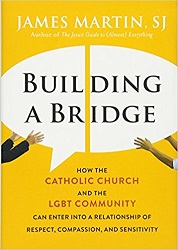
 Building a Bridge
Building a BridgeHow the Catholic Church and the LGBT Community Can Enter into a Relationship of Respect, Compassion, and Sensitivity
Reviewed December 16, 2017.
HarperOne, 2017. 150 pages.
Starred Review
After my son came out as transgender and I began referring to her as my daughter, I've been approached by several friends telling me that their own child is transgender, lesbian, gay, or bisexual. Most of those friends also attend my church. To all of those friends, I'm going to start recommending this little book, with its focus on letting LGBT folks know that Jesus loves and accepts them.
This little book was born out of a talk the author gave after the Orlando tragedy. At that time, he was saddened that not many church leaders spoke in support of the LGBT community, which had been so horribly targeted.
I found this revelatory. The fact that only a few Catholic bishops acknowledged the LGBT community or even used the word gay at such a time showed that the LGBT community is still invisible in many quarters of the church. Even in tragedy its members are invisible.
This event helped me to recognize something in a new way: the work of the Gospel cannot be accomplished if one part of the church is essentially separated from any other part. Between the two groups, the LGBT community and the institutional church, a chasm has formed, a separation for which a bridge needs to be built.
This is not a book about doctrine. I found that refreshing. He didn’t even approach the topic of whether or not having sex with someone of the same gender is sinful. (God Believes in Love, by Gene Robinson, is a good book for explaining from the Bible that it isn't.) In the chapter about respect, he says:
Recognizing that LGBT Catholics exist has important pastoral implications. It means carrying out ministries to these communities, which some dioceses and parishes already do very well. Examples include celebrating Masses with LGBT groups, sponsoring diocesan and parish outreach programs, and in general helping LGBT Catholics feel that they are part of the church, that they are welcomed and loved.
Some Catholics have objected to this approach, saying that any outreach implies a tacit agreement with everything that anyone in the LGBT community says or does. This seems an unfair objection, because it is raised with virtually no other group. If a diocese sponsors, for example, an outreach group for Catholic business leaders, it does not mean that the diocese agrees with every value of corporate America. Nor does it mean that the church has sanctified everything that every businessman or businesswoman says or does. No one suggests that. Why not? Because people understand that the diocese is trying to help the members of that group feel more connected to their church, the church they belong to by virtue of their baptism.
The three things he focuses on are in the subtitle: Respect, Compassion, and Sensitivity. And he’s not talking only in one direction, but says that both groups need to work on building the bridge from both sides.
On this bridge, as in life, there are tolls. It costs when you live a life of respect, compassion, and sensitivity. But to trust in that bridge is to trust that eventually people will be able to cross back and forth easily, and that the hierarchy and the LGBT community will be able to encounter one another, accompany one another, and love one another.
But I especially liked the section after the essay on bridge-building, because I didn’t expect anything like it when I picked up this book. This section has the title “Biblical Passages for Reflection and Meditation.” The biblical passages that follow are accompanied by questions for reflection and would be interesting to use in a small group setting. No, these are most definitely not the “clobber passages” used to assert that homosexuality is sinful, or explanations for how they should be interpreted. Instead, we have passages about how the church is one body, about the good Samaritan, about Jesus’ encounters with people who’d been excluded by the religious authorities of his day.
I like the passage about the disciples on the road to Emmaus, and especially this question: “At various points in your life, your eyes may also have been ‘kept from recognizing’ the presence of God’s grace in the life of your family member or friend. What opened your eyes?”
Finally, the book ends with “A Prayer for When I Feel Rejected.”
What a lovely book! I heartily hope that someday something similar will be written for the evangelical church. While we are waiting, there is much that Christians of any flavor can find to value in this one. Let’s build bridges, too!
